As a mountain gains popularity, come red tape and commercialization. These get order on the mountain, and allow for more people to climb it safely, but some people, call them purists or crazy, prefer not to get involved in such show. They prefer to fend by themselves without external aid. They climb for the achievement of their personal challenges, for their love of the mountains, for the building of their mountaineering foundation. Summiting is sought after, but not required; they climb for an adventure. They are who I refer to as alpinist.
This article is inspired by an essay titled “how to climb Kilimanjaro like an alpinist” (rdklein.fr/essays/kilimanjaro.htm). As for Kilimanjaro, it is easier to find information on Aconcagua about how it works, with tour agencies and kit lists, than how it is as a mountain, with water points and facts to justify gear, but at least it is possible to do it that way.
This article aims to provide unique information and provoke critical thinking for the person who wishes to take on the challenge of climbing Aconcagua unsupported, while optimizing his success rate and not spending a fortune. Work smarter, not harder, except…
Disclaimer
Is it more difficult to climb Aconcagua unsupported than with a commercial operation?
Not on the physical level, since the hardest day, the summit day, requires the same effort. But before and after, and on the mental and intellectual levels, it is a different beast.
If you follow this article, you will have to work harder. You will spend more time on preparation. You will need more experience and knowledge to be safe yet be more at risk. You will hate yourself at some point for getting yourself into this.
I have succeeded an unsupported climb in mid-February 2018, up the normal route and down the Polish traverse. But I am just another climber, so take everything here critically.
While I climbed solo, I would not do that again. Being the only person above 6000 meters during my summit day was an eye-opening experience of risk management (only worsened by having the selfie stick break in the wind for the summit shot!).
![Alone on Aconcagua's summit, and the selfie stick breaks in the wind]() Alone on the summit + broken selfie stick = balance the camera on a rock. Partly uncovering my face for a summit smile was a bad idea.
Alone on the summit + broken selfie stick = balance the camera on a rock. Partly uncovering my face for a summit smile was a bad idea.So, how do I climb Aconcagua like an alpinist?
To climb Aconcagua unsupported safely and without undue hardship, you want to:
- Consider the red tape and define support,
- Preacclimatize elsewhere,
- Choose your route accordingly,
- Use extra knowledge and skills on the mountain,
- Rethink the usual Internet kit list, and,
- Optionally, spend money only where useful.
The subsections below will describe these matters.
Play by their red tape, and define what is support
Some red tape will get in the way of your unconventional way of climbing, but it should not prevent you from doing so.
You will have to arrange your entrance into the park during its opening hours (8:00 to 18:00 in 2018), and pass by the approach camps and base camps when the ranger is awake, which should be easy. However, the clinic in Plaza de Mulas was open only 9:30 to 12:30 and 17:30 to 20:30, which may need to be considered in your plan. At least the lineup is shorter than back home in Canada!
![Waiting for the doctor]() Short lineup for the camp doctor.
Short lineup for the camp doctor.The clinic usually sees climbers only after a full rest day in base camp, but I asked to be seen the morning after my arrival since I planned to leave as soon. The doctor agreed to see me, said “I do not recommend that you ascend that fast, but you are free to do what you want. We will always be there if you need us”, and signed my permit. Good medical spirit.
What happens if you miss a signature on your permit? A guide told me I might get into trouble at the park exit from missing my check-out in Plaza Argentina (the ranger was still sleeping!). The ranger at Pampa de Lenas did not care, but he did stop me there as darkness was falling. So I stealthily left in the middle of the night and got out of the park before gate employees came at 8:00.
It is mandatory below the base camps to only camp in the designated camps. Mule trains move very early in the day, so wild campers will get caught. At the base camps, all climbers have to contract a company for a camp spot, water, toilets and garbage disposal. One can pay but not use the last 3 services, but the first was enforced. I therefore approached a random company in Plaza de Mulas, and the camp manager ignored that rule’s existence. She simply signed my permit, and asked for 5$/100ARS the next morning. In Plaza Argentina, the camp manager did not care and let me camp for free.
Where do you draw the line for defining support?
Most people will be happy with the above, as in plan only for support where it is mandatory, but welcome any gift on the way. See “Aconcagua in and out” on Summitpost for a good example. If you want to go to the extreme, consider the following:
- Go during low season to get less navigation cues from following other groups.
- Bring your own poop and waste bags, and use them even in the base camps where there are toilets. Put them in the park ones just before signing out.
- Refuse any gift of food, water and camp luxuries. Water in base camps can be gathered above where commercial operations have diverted them into camp.
- You can even get your own weather forecast instead of the ranger’s, and ignore the people coming down of their take on the route conditions.
- More philosophically, if the crowds, medical staff and helicopter on standby affect the safety precautions you take, is that also support?
I tried all but the water gathering and the risk management parts.
Acclimatize differently from them
If you are willing to carry 14 days’ worth of food in, go for it – it is doable – but read on.
The most valuable decision to make an unsupported climb more manageable is to preacclimatize elsewhere and climb Aconcagua alpine-style.
![Approaching base camp with full load]() 23kg 55l pack en route to Plaza de Mulas.
23kg 55l pack en route to Plaza de Mulas.Other benefits include:
- Less accumulated fatigue. Sleep at altitude on a mountain is never perfect. You can fit one or two hotel nights between the acclimatization climb and the real climb. Getting in position to summit within 3-4 days from the hotel bed will lessen the accumulated burden. Do not neglect mental fatigue too.
- Less risk of theft. Theft of unattended gear happens on Aconcagua. Making multiple carries and setting multiple camps would be risky when you have no one to watch over them.
- More potential time for acclimatization. Consumable weight being less of a concern, you can spend more time in altitude if your schedule allows for it.
- Gear adjustment. Can be done between the acclimatization climb and the real climb, especially if you use the first one as a gear test. Also includes repair or replacement of failed gear and charging of electronics.
- Weather check before leaving the city. May be not useful, but could be significant if a weather system is coming in.
![San Jose summit]() Testing the warmth of my clothing system on San Jose’s summit.
Testing the warmth of my clothing system on San Jose’s summit.![5550m col camp on San Jose]() Wild camp as high as possible on San Jose for acclimatization
Wild camp as high as possible on San Jose for acclimatization I acclimatized on San Jose, Chile, because it can be reached by public transit from Santiago, and there is a 5550 meters col where we camped for 2 nights (and I had a partner in Chile). In Argentina, Mercedario can be used, with no approach and a 5650m camp, but it costs a private transport to the trailhead (twice 225$ in 2018). Cerro Plata has public transit access, but its highest “campable” spot is lower at 5150 meters. Alternatively, climb locally before or make a stop en route to Argentina.
It is possible if prepared to only spend 24 hours in Mendoza for permit, food, fuel and gear rental to not lose acclimatization, but taking 2 days may be worth the extra rest.
And choose a different route too
The 360° route going up the Polish traverse and down the normal route is quite popular with commercial operations in 2018. Cited benefits include that
- the longer approach is better for acclimatization,
- it is less crowded, and
- the route is more scenic.
I disagree.
- Pampa de Lenas is lower than Puente del Inca; Casa de Piedra is lower than Confluencia; Plaza Argentina is lower than Plaza de Mulas. And you preacclimatized didn’t you?
- Since you are going 360°, you will see the crowds, and since you have preacclimatized, you will not spend much more time on the uphill side than the downhill side. More importantly, you lose acclimatization if you spend an extra day on a longer approach.
- Summit first, sightsee second.
Plan and ascend by the normal route and, once back to high camp after summiting, decide to descend by the Polish traverse should your energy and food reserve allow for it.
For this strategy to work, you must carry all of your gear to high camp, which you should for the risk of theft. On the other side, you save a day of consumables, and the permit is cheaper. Summiting from Nido de Condores is also an attractive option if not doing the 360°.
![Polish glacier in good condition]() Polish glacier in good condition and with no audible icefall midday. I wish I had a partner and gear to try it!
Polish glacier in good condition and with no audible icefall midday. I wish I had a partner and gear to try it!The Polish traverse now usually go by C3 Guanaco instead of C2 Polish (see map in the next section). I suggest going by C2 Polish, to see the Polish glacier and both the Vacas and Guanaco valleys from higher.
Most timings on the Internet come from supported groups doing multiple carries without previous acclimatization. For what it is worth, here are mine following the strategy here, including breaks but not stops. Pack weight was 23kg at the beginning. I planned for 2 rest or weather days but did not use any.
- D1. Puente del Inca – Horcones, 0:45. Horcones – Confluencia, 2:15. Confluencia – Piedra Ibanez, 4:00. Piedra Ibanez – Plaza de Mulas, 3:45 (tired near the end).
- D2. Plaza de Mulas – Canada, 3:00. Canada – Nido de Condores, 2:30.
- D3. Nido de Condores – Colera, 3:00.
- D4. Colera – Independencia, 2:15. Independencia – La Cueva, 1:45. La Cueva – summit, 2:30 (-15C, good visibility, 50km/h wind). Summit – Colera, 1:45.
- D5. Colera – C2 Polish, 2:30 (+0:45 lost for navigation mistake). C2 Polish – C1 Polish, 1:45. C1 Polish – Plaza Argentina, 1:45.
- D6. Plaza Argentina – Casa de Piedra, 3:45. Casa de Piedra – Pampa de Lenas, 5:00 (wet feet and blister for last third). Pampa de Lenas – Punta de Vacas, 5:30 (done in the dark).
Also, D0 afternoon bus to Puente del Inca and D7 morning hitchhike to Uspallata.
For comparison, other timings on the same trip include San Jose 8 hours from bus stop to Plantat, Ojos del Salado 14 hours from Atacama to summit and back, and Mercedario 9:30 from Hoyada to summit and back.
Gather more knowledge and skills than others
By going unsupported, you will need knowledge that are irrelevant to commercial clients, and such information may be difficult to find on the Internet. You will also need skills that are not required for them, as you have decided and will need to fend for yourself.
You have just tacked on an extra mental and intellectual challenge to the climb.
Mountain knowledge
In 2017-2018, 3144 ascent permits were issued, 923 from Vacas valley and 2121 from Horcones valley. Another 3141 trekking permits were issued. In 2012-2013, there were 62 search and rescue missions and 170 evacuations for 5551 permits. 33 fatalities occurred for 42731 summit attempts between 2001 and 2012 (0.77 per 1000). Success rate is everyone’s guess.
People everywhere like to brag about weather. While it can be -25C, snow 10 cm/h, and gust 100 km/h on Aconcagua, these are generally avoidable by looking at weather forecasts. I measured -15C in my tent at 6000m at 6:00 and at the summit at 14:15. Two guides I have talked to found that day to be average temperature-wise, which I believe after having looked at forecasts for weeks and at how others are dressed on their summit pictures.
For water, plan generally on carrying one-day worth of it. Clear water can be found in every approach camp, base camp and C1 Polish. I found no clear water between 3.3km after Confluencia and Plaza de Mulas. There is a rather reliable water source at 3810m between Casa de Piedra and Plaza Argentina and a few between Pampa de Lenas and Casa de Piedra on river right. Camp Canada was dry. Nido de Condores, Berlin, Colera and C2 Polish have reliable snow. C2 Polish may have liquid water on a sunny day. Treat any water as suspect considering the crowds.
They ask if you have insurance when you get the permit, but it is not mandatory to have one.
![Aconcagua map]() Upper Aconcagua map.
Upper Aconcagua map.![Crossing of Vacas river if skipping Casa de Piedra]() Cross Vacas river here if skipping Casa de Piedra.
Cross Vacas river here if skipping Casa de Piedra.I could not find a good map in Mendoza. Print one before (I like opentopomap.org).
Check A. Buttini line 401 for the 3.5-4-hour bus ride to the trailheads.
I had no success hitchhiking from Puente del Inca to Horcones, but it is easier from Punta de Vacas since there is a police checkpoint, where the officer offered to ask for me.
Navigation is straightforward in good weather. GPS can get unreliable in the lower Vacas valley. If skipping Casa de Piedra, ford the river only once and at S32° 42.076' W69° 49.700', walking on climber left / river right upstream of that point. On the Canaleta, keep climber right to the snow. There may be no track between Colera and C2 Polish, just make a same elevation traverse around 6000m or take a 105° bearing across the snowfield until you meet the Independencia – C2 Polish track. Magnetic declination should stay at less than 1° for many years.
The Berlin huts were usable and empty when I was there. The Elena shelter, supposedly only accessed by calling a ranger for the lock combination during an emergency, was however filled with group gear.
Mountaineering skills
![Do you go with that forecast?]() Summit forecast calls for -15C with 90km/h wind; you calculate a -33C windchill. You wake up to no wind and clear skies in Colera at 6 am. The only other party is still sleeping. Do you go?
Summit forecast calls for -15C with 90km/h wind; you calculate a -33C windchill. You wake up to no wind and clear skies in Colera at 6 am. The only other party is still sleeping. Do you go?On Aconcagua, the thousands paid for a guide is not for his navigation help, but for his mountaineering skills. This should be a major consideration when choosing to go unsupported. All the skills should sunken in already. If not, reconsider the decision of going unsupported.
- Self-preservation. Staying warm and dry, melting snow, cooking inside tent, setting camp in wind, keeping morale, maintaining partnership, managing batteries…
Can you manage yourself and your team day after day while maintaining situational awareness, in the fatigue of days of climbing, tent-bound in a blizzard, and with the effect of altitude?
- Expedition medicine. Can at least two people on the team recognize and manage altitude sickness and other travel and hiking-related conditions?
- Weather. Can you interpret and make proper decisions from the weather forecasts? Can you get additional input from the sky, barometer and other field observations?
- Planning. Can you estimate the time required for each leg? The gear you need or need not? The caloric intake required? When to turn around? How much fuel to bring?
- Navigation. Can you find your way if lost, in a whiteout or your GPS dies?
- Improvisation. What if any piece of gear fails? If a team member becomes unable to continue?
Rethink the typical gear list, and spend wisely
Commercial operations have liability toward their clients, and their gear list reflect that. They may not disclose some weight- or budget-saving information. They may even want you to hire porters or rent their gear. They would rather have you fit in their business model than try something else.
As an unsupported climber, you are trying something else, and your priorities will be different. Think critically.
The following table shows the gear I had with the exact model for the key ones, also showing where I cut or would cut weight or money compared to the usual commercial operation kit list. However, it is not to be copied, but read with the following text to make your own decisions.
![Unnamed Image]() Gear list for Aconcagua unsupported.
Gear list for Aconcagua unsupported.Clothing
Less is more here. I believe -25C is a good limit to aim for, and -15C for average. Since you need to minimize weight, at that temperature, you should be wearing all your layers and have nothing extra except accessories. If you are not going to wear it at -25C, don’t bring it. No approach clothing, no softshell, no camp booties. Then mix and match to make these clothes work up to 25C.
For me, the top was a baselayer, midweight fleece, light down jacket, midweight down jacket and light ski jacket, sized jr XL to men M for all 5 to fit over each other for the summit bid. The bottom was a baselayer, light midlayer also worn for the approach, and non-insulated ski pant. I wore a waterproof trail runner up to Nido de Condores and C1 Polish, and a 6000-meter boot above (sized US12 for street 10.5). Lighter boots with foot warmers can also work. On the hands, I had a light liner, midweight glove and light overmitt. All were fine warmth-wise, even if some were not mountaineering-specific (ski = heavy) or were cheap (many generic brand, midlayer pant was a thin pyjama from Walmart). The glove system may not have handled -25C, and I was missing a water-crossing footwear for the Vacas exit.
If you have to choose, put money on insulation and not moisture management; I had no Goretex, merino wool or softshell. Rain is rare on Aconcagua, and the air is dry. It is hard to move fast enough to sweat while setting a pace to not have to stop and get cold.
Camp and kitchen
Many people including me had a -18C sleeping bag to save weight. Consider sleeping dressed if it gets colder. For the mattress, you will be sleeping mostly on small rocks and not snow, which means less need for insulation; I had no trouble with R4.4.
![Bivy tent in the wind in Colera camp]() 100$ tent in high camp, proud but feeling the crosswind. Should have built the wall before setting up the tent, it takes long in altitude.
100$ tent in high camp, proud but feeling the crosswind. Should have built the wall before setting up the tent, it takes long in altitude.![Two different snowmelt setups]() The snowmelt setup at Colera of a neighbor’s guide vs mine.
The snowmelt setup at Colera of a neighbor’s guide vs mine.The tent needs to survive wind, but snow loading is rare in the upper mountain as it gets blown away. Considering that, I brought a sub-100$ bivy-tent, since its low design made it very wind-resistant despite being not very snow-resistant. You will probably only bring one single-walled tent if in pair, for weight limitation and theft risk, but make sure you can cook in there. No need for pegs, you will be anchoring with rocks.
I went with a single ultralight backpack, but since the summit day is more difficult than any other day, I would redo it with a 2-pack strategy.
Being skilled to use a canister stove in the cold is definitely a plus for saving weight and fuel and cooking inside the tent. I planned for 3200kcal/24h and ate about 2500 even if preacclimatized, so do not pack too much. A small water filter can save a lot of fuel by avoiding the need to boil, but be prepared to backwash it in the field. Sun can melt snow packed in a clear bottle on an average day below Berlin.
Liquid fuel and canister fuel can be found at Orviz and probably all the other outdoor gear stores in Mendoza. You can also rent pretty much everything there (useful for lost luggage!), but most will be rather old. Carrefour is a good one-stop shop for food.
Technical, electronic and other gear
![Angle of Canaleta]() Angle of Canaleta. Judge what you need to climb safely.
Angle of Canaleta. Judge what you need to climb safely.The Canaleta maxes out at 30°, and it should never ice up (it is not a glacier and is too cold for freeze-thaw), so go either cheap or light. Aluminum or 10-point crampons will suffice. With enough experience, you can even forgo the ice axe. For the helmet, judge yourself from pictures if it is steep enough for rock fall to frequently reach head-height (I do not think so). The rocky terrain is harsh for carbon poles.
Have some way to get weather forecast should you refrain from the ranger’s forecast. Keep a VHF radio only for backup (142.8 MHz). Try not to have to charge any battery by keeping all electronics off unless needed. Test alarm clock, headlamp and GPS at -20C.
The miscellaneous category will see you bring more than the typical online list. It is amazing how some lack even basic hiking essentials as guides take care of them.
For the penny-pincher
Saving money should not be the goal of going unsupported.
Yet, budgeting is an unavoidable part of any trip.
Daily cash withdrawal limit being low in Argentina and the withdrawal fees high, come prepared with enough USD to exchange locally, or go for wire transfer.
![Food prep for 8 days]() 35000CLP and 25Mcal worth of food. All bought in Santiago except the freeze-dried. In the upper re-sealable bags are sausage tortillas and cereals with powdered milk.
35000CLP and 25Mcal worth of food. All bought in Santiago except the freeze-dried. In the upper re-sealable bags are sausage tortillas and cereals with powdered milk.![Aconcagua walk-in prices February 2018]() Prices given upon asking for piece-wise support in Mendoza.
Prices given upon asking for piece-wise support in Mendoza.At 20 ARS = 1 USD in February 2018, it was relatively easy to spend only 400$ per person plus permit airport to airport. I spent about 100$ for backpacker quality food, transport and sleep in Mendoza and Puente del Inca, and another 100$ in and around Santiago and to Mendoza for the acclimatization climb. 8$ per person per day can get decent expedition food from the groceries. Low-season saves on the permit.
Just for sake of it, I estimate I had about 4000$ worth of cloth and gear on me, not counting the camera and cell phone, which is probably on the low side (see gear list above). But that number should not mean much since you should have quite some gear from previous trips already.
If you want to know how much you saved by going unsupported, the picture above shows prices for support in 2018. Beer was 10$ in the base camps and meals, 40$. A helicopter ride out of Plaza Argentina? 2000$.
So, should I climb Aconcagua like an alpinist?
Remember that there is no right or wrong way to climb a mountain. Summiting Aconcagua is an accomplishment even if one slept in a cot in base camp and did not lit a stove a single time.
Just because you are crazy enough to ignore other people’s smile because you consider that to be psychological support does not mean you should not smile to them.
![Guided group of 27 on Aconcagua]() A group of 27, plus guides. They are normal, not us.
A group of 27, plus guides. They are normal, not us.


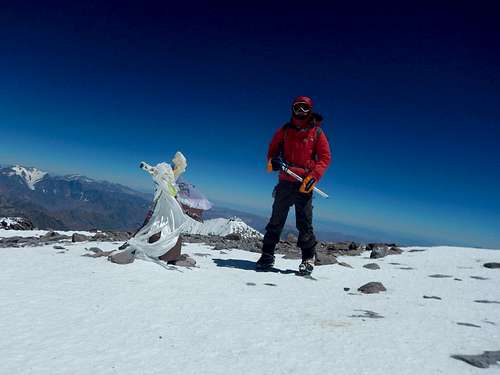
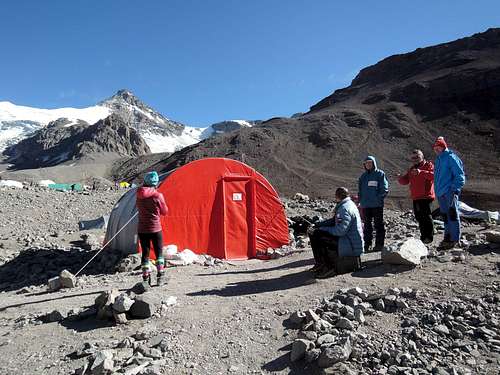
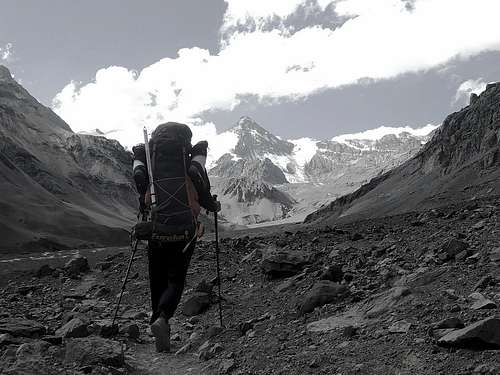
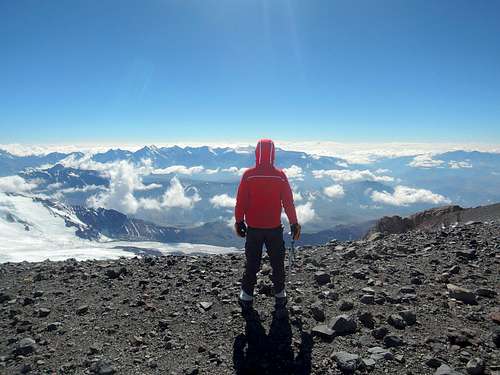
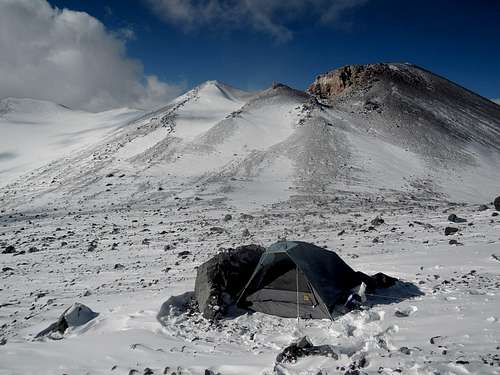
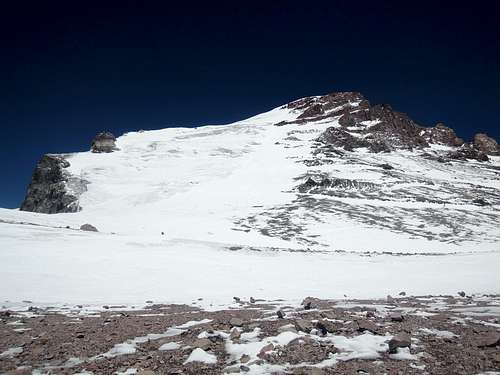
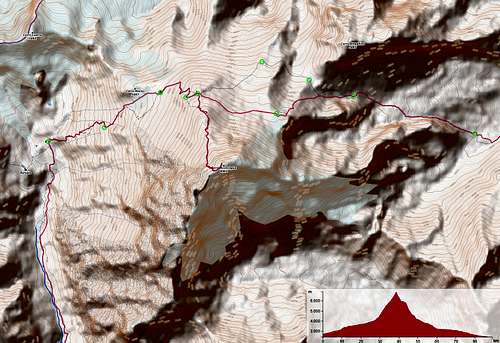
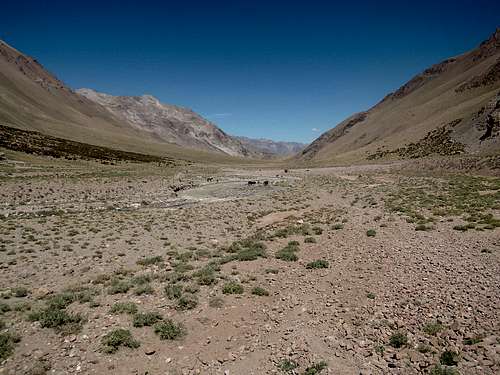

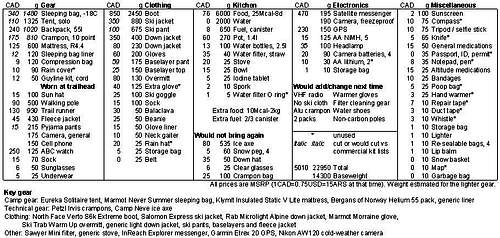
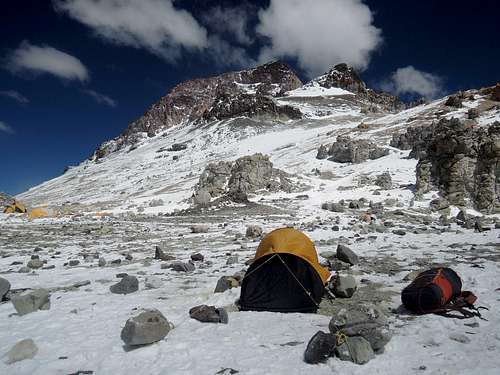

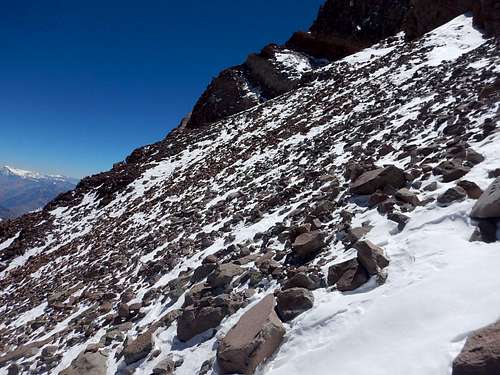
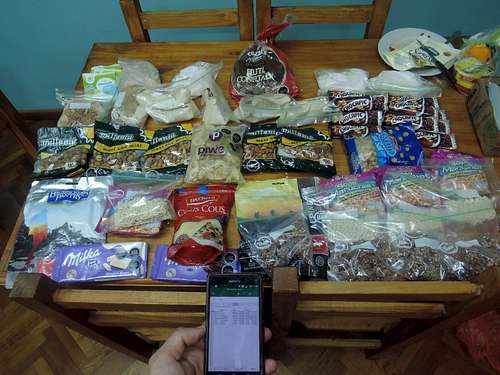
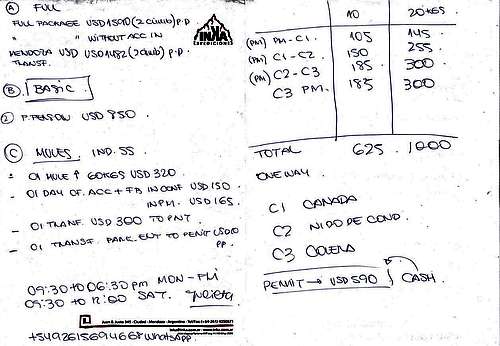
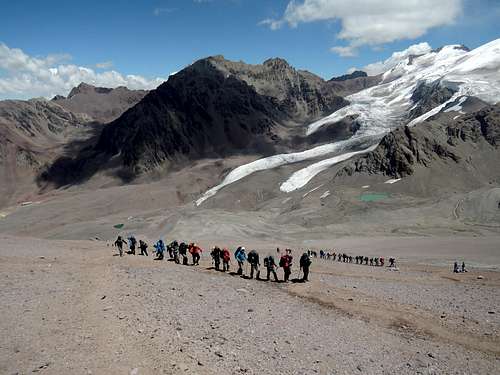



Comments
Post a Comment